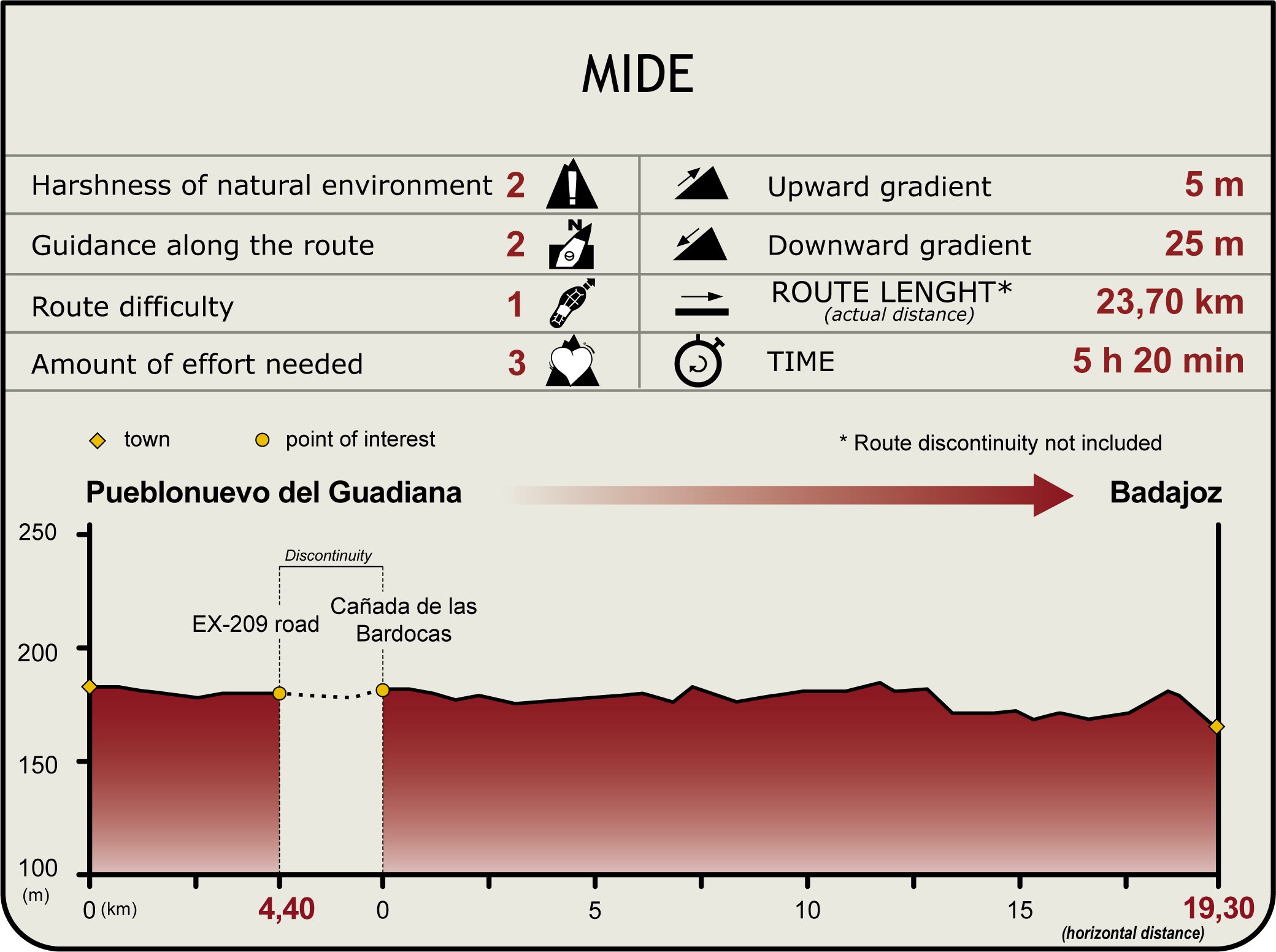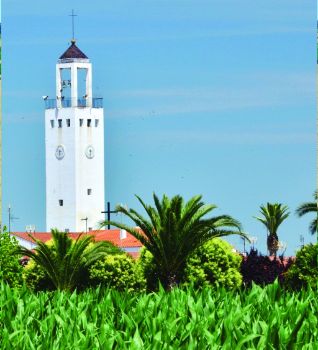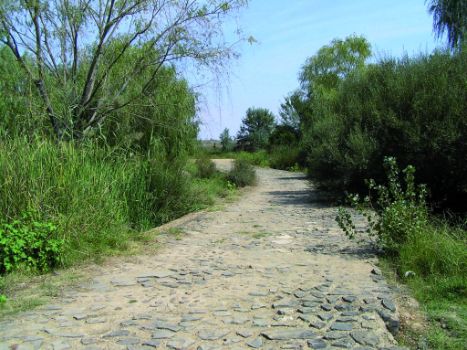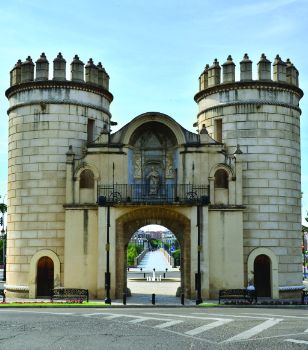Net of Natural
Trails

Stage 35: Pueblonuevo del Guadiana - Badajoz
Description
From Vegas Bajas to Badajoz
The Stage begins at Pueblonuevo, near the banks of the River Guadiana, and runs to Badajoz through farmland. The production of corn, tomatoes, fruit and vegetable clearly indicated that the route is passing through the Vegas Bajas.

The dirt road out of Pueblonuevo, which crosses a Roman road, leads to the stretch shared with the previous Stage (refer to the end of Stage 34). Stage 35 then heads towards Badajoz along this dirt road until it reaches the intersection with EX-209, where the road interrupts the Trail. The Stage starts again 2.7 km further on, in the northeast direction, along the road to Alcazaba. About 500 m from the bridge over the ongoing AVE construction works, the route turns left onto a dirt road that runs parallel to the secondary branches of Montijo Canal.
The Trail traverses through the southern boundary between Novelda del Guadiana and Sagrajas, two farming hamlets of Badajoz, whose main products are corn, tomato, fruit and vegetables. The local industries belong primarily to the agri-food sector.

The Stage ventures between the railroad and Montijo Canal until it reaches a photovoltaic power plant that will not go unnoticed, owing to the number of photovoltaic modules it has.
The Trail approaches a signposted intersection to Gévora, a farming town located five kilometres from Badajoz. The town has undergone a major transformation in the last decade, as it developed into a commuter town for the province's capital.
The route arrives at the intersection with the EX-100, the road from Badajoz to Cáceres, which one must cross with caution. It then continues along a path leading to the intersection with the EX-110 to Albuquerque, from where it heads along the Cañada Real Sancha Brava.

The Stage continues along this drover's trail until it crosses the EX-100 again via a tunnel, to continue on the left side of the road towards Badajoz. It heads down a dirt road for a few metres towards the old EX-100, which it also crosses at a roundabout. Caution should be exercised here. Soon after, the route continues to the left, parallel to the old EX-100 road to Badajoz and the motorway, the first road that runs perpendicular to the route. The road crosses the A-5 again via a marked tunnel.
The Stage reaches the River Gévora, a tributary of the Guadiana, which has been declared a Site of Community Importance (SCI). The route crosses the river via an overpass and arrives at a rest area. At the complex combination of intersections near Gévora, the route coincides with the Cáceres-Badajoz Corridor Nature Trail. Both Trails run alongside each other until past the Badajoz diversion dam. The River Gévora is forded at a site with lush vegetation that may be flooded.

The Stage crosses under the EX-100 via an underpass, and continues along this road for about 500 metres towards Badajoz, keeping to the right side. It now turns onto a dirt road parallel to the EX-100, along which it continues for about 1.7 km. It now drifts away from the EX-100, turning slightly to the right, running along the Cañada Real Sancha Brava through croplands, towards the intersection with the old paved road of Montijo Canal. The route again drifts toward the EX-100 in the direction of Badajoz, and crosses the road at a pedestrian crossing. It then continues to the right along the shoulder parallel to the River Guadiana, toward La Autonomía Bridge, the endpoint at Badajoz.
Sites of interest
Profile

Highlights
Further information
Badajoz
The Alcazaba, with its Albarrán watchtowers, was built during the Muslim rule to gain strategic control of the area. One of the best-known towers is Espantaperros. The fortress-palace of the Duke of Roca (16th c.), built in Mudejar style, can be found inside the Alcazaba. It is today the Provincial Archaeological Museum.
The 15th-century cathedral, located outside the city walls, was built as a defensive structure. It has three naves and a bell tower capped by a balustrade with Gothic and Plateresque windows. Another interesting landmark is the Provincial Museum of Fine Arts, with works by Luis de Morales, Zurbarán, Felipe Checa and Eugenio Hermoso, amongst others. Next to the museum stands the Moorish tower called "La Giralda".
The former prison of Badajoz houses today the Museum of Extremaduran and Latin American Contemporary Art (MEIAC), with works by Barjola, Godofredo Ortega Muñoz and Timoteo Pérez-Rubio, as well as temporary exhibitions of Latin American art.






